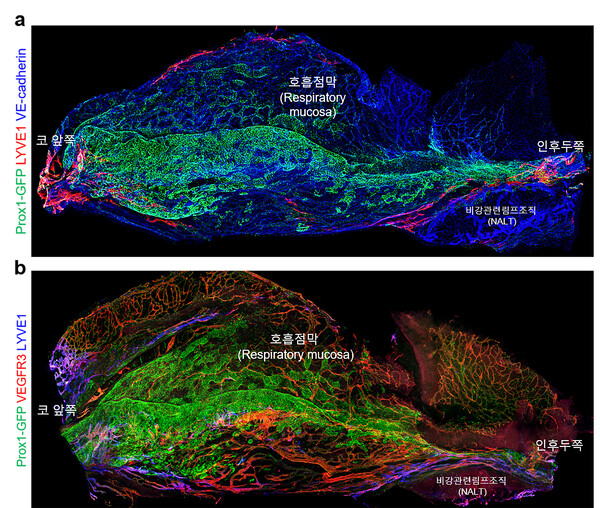Researchers at the Institute of Basic Sciences (IBS) have successfully mapped blood and lymph vessels in the nasal cavity in three dimensions for the first time in the world, revealing key observations for improving mucosal immunity.

The nose is both a sensory organ responsible for smell and the first gateway for external air to enter the lungs. However, it also serves as the first immune barrier to prevent external pathogens.
The vascular research team led by the IBS Center of Vascular Research head, Professor Koh Gou -young, identified cilia epithelial cells, which account for the majority of mucosal epithelial cells, as a major target for early Covid-19 infection and proliferation.
Accordingly, they suggested that forming mucosal immunity through intravascular vaccine administration could be an effective Covid-19 prevention and treatment strategy.
Microvascular and lymphatic vessels play an important role in forming mucosal immunity because it acts as a pathway for immune cells to travel to the lymph nodes and back to the nasal mucosa. However, the three-dimensional structure and cell-level characteristics of the nasal cavity have not clearly been elucidated.
The researchers used immunofluorescence staining to mark antibodies that selectively bind to specific proteins in cells or tissues to be labeled with fluorescent substances so that their reaction and pathway can be observed. Accordingly, they identified molecular cell-level characteristics of immune responses together with single-cell genetic analysis using the three-dimensional map of microvascular and lymphatic vessels in the mouse and human nasal cavities.
Particularly, they confirmed that venous sinus vessels are distributed widely in the nasal cavity and atypical lymphatic vessels with sharp-ended capillaries occupy the majority of the nasal cavity compared to the rounded shape of common lymphatic vessels.
They associated the distribution of these blood and lymphatic vessels with the ability to better carry out immune responses to prevent pathogen invasion. Furthermore, the VCAM1 protein, which plays an important role in immune cell migration in venous sinus vessels, was more highly expressed in atypical lymphatic vessels than those in other organs.
Moreover, the researchers observed that rhinitis caused venous sinus blood vessels to shrink but expand for Covid-19 in animal-based models. They also noted that with age, the venous sinus blood vessels expanded abnormally with age and found that the physiological and immune function in the nasal cavity weakened due to various pathologies.
"This first three-dimensional map of blood vessels and lymphatic vessels in the nasal cavity lays the foundation for improving research on drug administration in the nasal cavity," Koh said.
Hong Seon-pyo, the first author of the study, also commented that the study suggests that effective mucosal immunity against viral infections can be established by activating specialized blood vessels and lymphatic vessels in the nasal cavity.
The study was published in the Nature Cardiovascular Research journal on March 21.

